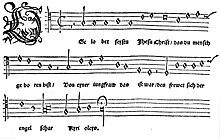Gelobet seist du, Jesu Christ
| "Gelobet seist du, Jesu Christ" | |
|---|---|
| Hymn by Martin Luther | |

"Gelobet seystu Jhesu Christ" in Walter's Eyn geystlich Gesangk Buchleyn
|
|
| English | Praise be to You, Jesus Christ |
| Text | by Martin Luther |
| Language | German |
| Published | 1524 |
"Gelobet seist du, Jesu Christ" ("Praise be to You, Jesus Christ") is a Lutheran chorale of 1524, with words written by Martin Luther. It was first published in 1524 in the Eyn geystlich Gesangk Buchleyn. For centuries the chorale has been the prominent hymn (Hauptlied) for Christmas Day in German speaking Lutheranism, but has also been used in different translations internationally. It has appeared in hymnals of various denominations including the Catholic Church.
Luther expanded a pre-Reformation stanza which is attested in Northern Germany in the 15th century, mainly in prayerbooks from the convent of Medingen, based on Grates nunc omnes, the Latin Sequence of the midnight mass for Christmas, by six stanzas. Each stanza ends on the acclamation Kyrieleis. The hymn was published in Eyn Enchiridion in Erfurt in 1524.
The tune was first printed in Eyn geystlich Gesangk Buchleyn, a booklet of spiritual song, collected by Johann Walter but is attested also in the prayerbooks from the convent of Medingen and even appears on an antependium made by the nuns in the late 15th century. It seems likely that both Luther and Walter collaborated to modify an older melody. In the first verse, the highest notes accentuate important words such as Jesu, Mensch (man), Jungfrau (virgin), Engel (angels).
Balthasar Resinarius composed a chorale motet, printed in 1544. A setting of Walter is dated 1551, Antonio Scandello's 1575. Lucas Osiander wrote a four-part setting in 1586, Erhard Bodenschatz in 1608, Samuel Scheidt wrote two settings in 1650. A five-part motet of Johannes Eccard was printed in 1597, one of Adam Gumpelzhaimer in Augsburg in 1618, Andreas Raselius wrote a five-part setting in 1610. Melchior Schärer (1570–1602) set the hymn as a motet a cappella for three parts, and Michael Praetorius composed various settings. Johann Hermann Schein wrote a cantata for three parts in 1618, Johann Crüger set it for four voices, two obbligato instruments (violins) and continuo.
...
Wikipedia
